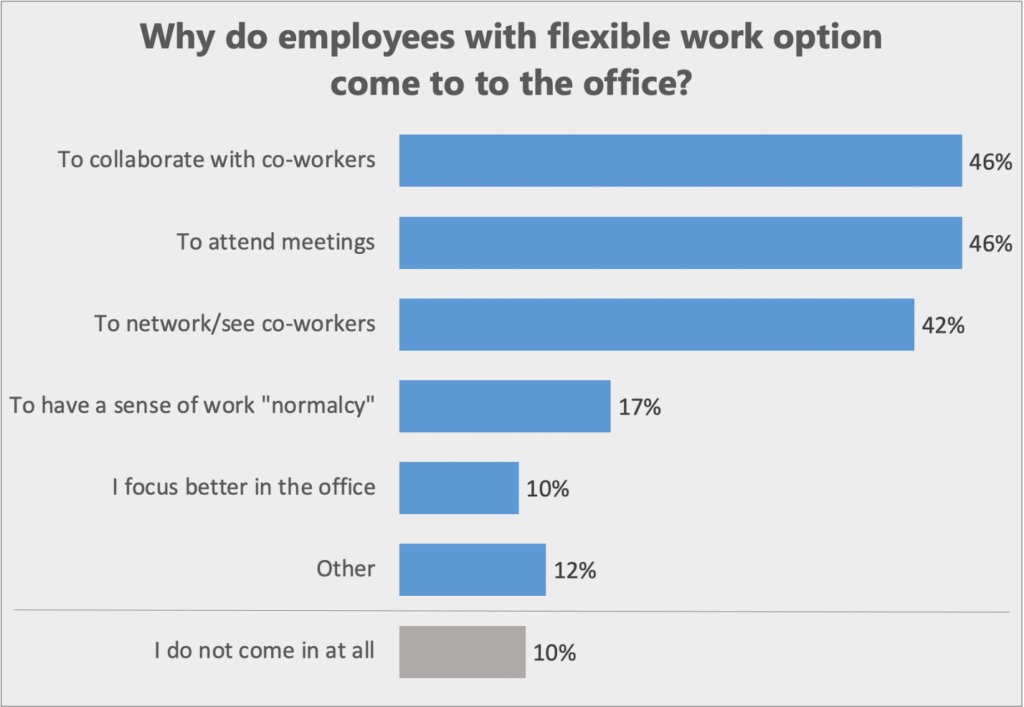
Key considerations for shaping organization culture in the remote-work world
Early in the summer, I was chatting with an Ann Arbor-based tech company executive about how their organization is navigating the remote-work world. The company’s culture is defined by young talent who expect to make friends at work and who express their needs vocally. The executive said that in the hybrid world, the company was severely limited in how it could nurture its culture. They couldn’t do impromptu strolls to the local ice cream shop because that would leave their remote peers out. They struggled to make work meetings equitable for those online. They couldn’t casually strike up a conversation with new team members as easily as they could in the past. So, the company was looking for ways to make the employee experience more consistent regardless of where people worked.
A familiar challenge
As we emerge from pandemic lockdowns, companies are asking whether to ask employees to return to the physical office, go completely remote, or enable hybrid work.
Working at the office was normal for most companies before the pandemic and leaders knew how to shape and evolve an in-person culture. But, navigating remote work on a more permanent basis — not just as a pandemic stop-gap — is uncharted territory.
Key considerations for shaping organizational culture
My company, Culturebie, has run surveys at over a dozen American companies over the last two years; incorporating rigorous research about the future of work, we have a deep sense of how employees as a whole feel about remote/in-person formats. Meanwhile, we have also heard from business leaders about their hopes and expectations.
The most common reason we’ve heard for allowing remote work is to attract and retain talent. Knowledge workers who experienced remote work during the pandemic have come to expect it. But, there are challenges to making remote work successful, especially in the long term. Approaching organizational culture — i.e. figuring out “how things get done” — requires the most adjustment. What do leaders need to keep in mind while shaping organizational culture in this new world of work? We see five aspects of employee experience that leaders must take into account.
Spotlight on well-being
Employee sentiment is in flux. Unprecedented global events are forcing employees to evaluate what they want to achieve from their work-life. A recent survey reported that one in four employees is experiencing burnout (McKinsey, 2022). Our surveys show well-being to be among the top five employee concerns.
Burnout is exacerbated among remote workers who depend on virtual meetings to connect with their co-workers. Studies suggest that as much as 69% of remote employees are experiencing burnout (CNBC, 2020) and that moving from full-time office to full-time remote work increases loneliness by 67 percentage points (The Atlantic, 2021).
More than ever, organizations need to be in tune with employee sentiment and tailor benefits and resources in a way that is sensitive to employee morale.
Role of managers
Never before has the role of a manager been as critical as it is now. When transitioning to remote work, immediate managers are the ones who make or break employee experience. Most often, managers are empowered to determine the specific terms of remote versus in-person work. On the one hand, rigid, empathy-less managers can create an oppressive, inflexible culture. On the other hand, laissez-faire managers might leave employees feeling lost. A middle path of flexibility and fairness is difficult to achieve.
Thus, organizations should invest as much as possible in manager capability development, through coaching, mentoring, training, and other resources. Attention should also be paid to who is given management responsibilities – excellence as an individual contributor might not be enough to ensure strong management.
Connectedness with the company culture
One recent poll shows that only 24% of remote workers feel connected to their company’s culture (Gartner, 2022). Despite an overdose of virtual meetings, 43% of remote workers say that they feel left out (Work Trends Report, 2022). In Cutlurebie’s data, we found that one reason why employees with flexible work arrangements go to the office is to connect with co-workers. Those who feel a part of the company culture feel more engaged, are more productive and are less likely to leave.
Some methods to create higher connectedness with the company include thoughtful new employee onboarding, assigning career and peer mentors, holding company and team events (virtual or in-person), and designing physical workspaces to enable serendipitous interaction.
Equity across employees
Fairness — both in who is allowed to work remotely, and who benefits from what mode of work — is an issue that the pandemic highlighted. According to a McKinsey survey, 61% of men have been offered the opportunity to work remotely, compared to only 52% of women (Fortune, 2022), yet women — are far more likely to prefer to work from home (New York Times, 2021). Meanwhile, single employees sometimes complain that employees with children are given more flexibility (Harvard Business Review, 2018).
There are also questions about work type. Some jobs require being in-person. Others don’t. While such differences are inevitable across industries (e.g., restaurant wait staff who need to be in person versus call center workers who don’t), the differences can seem unfair when they occur in the same office (e.g., IT staff who tend to physical servers and software engineers who can work from home). Employees with the flexibility to schedule calls around child pick-up can cause resentment among colleagues required to work set hours in person. Our surveys are full of such examples in open-ended responses.
Thus, careful thought and deep engagement with employees are necessary to ensure remote work policies are perceived as fair.
Performance matters
Some argue that it shouldn’t matter where you work from as long as you deliver on your goals. But, especially for remote workers, there is a risk of remote workers being assessed poorly compared to their in-person colleagues. One study found that remote workers accomplished more but were promoted less (Bloom et al., 2015).
Having a robust feedback and performance mechanism ensures that employees are judged on concrete deliverables and not on intangible aspects such as visibility in front of senior leaders. Clear performance mechanisms also help the company track how in-person and remote work is enabling and hindering company goals and targets.
Listening to employees has never been more important
Studies consistently show that leaders overestimate what they understand of their employees (Harvard Business Review, 2015; Testa, 2001). This problem is heightened with less in-person work.
Instead of speculating about what employees want, listening to employees ensures that companies arrive at the right policies and practices that work for their people. After all, every employee is unique, every employee group is unique, and every company is unique. Adopting practices that work for one company may backfire in another. Tailoring solutions to your workforce will guarantee more success, much faster.
So, “employee listening” through surveys and conversations is more critical than ever, and the qualitative information gained from them can be just as important as the statistics.
People-focused companies embed employee listening systems to get ongoing feedback from their employees. They use these listening systems to make data-driven decisions about their people and culture, and also monitor the impact of their decisions. For such companies, company culture will evolve seamlessly.
Be sure to check out Jasmit’s other contributions about company culture!
In Tough Times, Company Culture Makes the Difference
